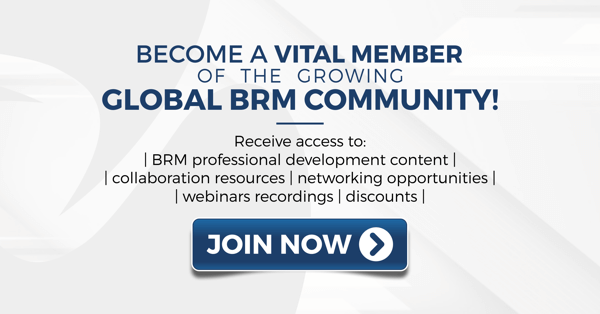The Business Relationship Management (BRM) Job Description

Designed to bring value to an organization through the convergence of different functions, someone in the business relationship management (BRM) position is a senior-level, strategic partner who shares ownership for both organizational strategy and value results.
Whether it be Technology, People, Finance, sales, legal, or external, a BRM’s primary objective is to break down the silos separating organizational functions to optimize cohesive effectiveness and jointly determine strategic direction. Today, the most forward-thinking, long-lasting organizations are those that converge functions through a BRM capability. The end result is a drive towards collaboration and a culture of creativity, innovation, and value that reflects the organizational strategy as a whole.
Across every industry, organizations have room to grow their value through the hiring of BRMs. While BRMs come from a variety of functions, the position requires a specific set of skills including strong communication, strategic thinking, and influential relationship-building.
The BRM Job Description
“Great leaders create great leaders in everyone around them. BRMs are great leaders.”
– Aaron Barnes, CEO BRM Institute
An individual fulfilling the Business Relationship Management function is expected to have the competencies required to advance the BRM Capability. A Business Relationship Management Capability is everything it takes, both visible and behind the scenes, to nurture relationships creating a limitless supply of energy necessary to evolve culture, build partnerships, drive value, and satisfy purpose. A BRM Capability facilitates culture advancement, driving it to one of trust, creativity, innovation, authenticity, and shared ownership across the organization. A mature BRM capability converges cross-functional teams to create holistic strategies that deliver organizational value and meaningful results.
Take a deeper look into what the competencies of a BRM look like and get your copy of the BRM job description template!
Title Variants
- Chief, Business Relationship Management
- Chief, Relationship and Strategy Officer
- VP, Business Relationship Management
- VP, Value Management Officer
- VP, Business Information Officer
- Director, Business Relationship Management
- Director, People Partner
- Director, Strategic Partner
- Director, Technology Partner
- People Relationship Manager
- Business Relationship Manager
- Business Capability Manager
- Technology Partner/People Partner/Finance Partner/etc.
What You Enjoy
Ideal candidates for this role will innately be self-actualized, relationship-centered, playful, fearless, and purposeful.
What You'll Be Doing
Evolving culture, building partnerships, and driving value to satisfy and elevate our organizational purpose.
- Partner with leaders both inside and outside the organization to collaborate and ensure meaningful results from our strategic initiatives.
- Optimize organizational factors, such as brand, infinite, technology, innovation, and human to amplify fit-for-purpose impact.
- Proactively sense and anticipate changes affecting strategy in the environmental landscape including organizational improvements, technological advancements, and evolving organization needs.
- Drives and ensures results across the organization based on our organization’s triple bottom line of people, purpose, and planet.
- Living up to the business relationship manager code of ethics daily.
Evolve Culture
- Advance the BRM capability beyond just the role and function, sharing ownership with the full BRM community of practice for continual improvement
- Champion a culture of shared ownership and constant organizational evolution
- Elevate the importance of language across the organization as a crucial element to effective communication
- Create leaders in everyone around you, e.g., leadership-as-a-practice
- Coach organization leaders to articulate their vision and requirements to drive the organizational value, e.g., people, purpose, and planet
Build Partnerships
- Own the strategic relationship between the BRM function and partners to stimulate, surface, and shape demand
- Develop deep domain knowledge of your partner’s organizational functions
- Build cross-functional relationships for the convergence of value
- Establish value management as a strategic organizational capability
- Educate partners on the BRM Mindset, e.g., powerful communications, approaches, roles, and capabilities
- Establish a communication methodology for effective and efficient organizational communication
- Partner with individuals, teams, and organizations to drive value and meaningful results
Drive Value
- Continually improve the value framework to drive organizational awareness and education
- Partner with leaders to identify opportunities to evaluate, sequence, and, shape initiatives for strategic value
- Focus on value over solutions. Emphasize value when developing ideas, evaluating risk, and evolving needs
- Innovate using knowledge and awareness of industry trends to identify new opportunities
- Elaborate the strategic plans for partners to communicate their strategic capabilities
- Monitoring initiative progress to ensure expectations are aligned with results and ultimately value
- Ensure that allies in strategic purpose are knowledgeable about objectives; engage as a project/program major partner including evaluating development efforts and progress against strategic plans and value creation objectives
- Collaborate with leaders across the organization and share ownership of maturing the BRM’s function
- Communicate partner value by quantifying impacts and clearly articulating value realized.
Satisfy Purpose
- Advocate as a champion of change for your partners strategic plans
- Facilitate goal-setting by communicating a shared purpose specifically shared value, beliefs, and behaviors
- Validate the organizational purpose supports the desired results. This can be achieved through business case development, financial awareness, managing expectations, the identification of opportunities to grow value or a combination.
- Understand how purpose drives organizational decisions
- Encourage leaders to understand the organization’s impact on society, the planet, and its longevity and purpose in the world
- Align each initiative to the organizational strategy to validate expected results
- Strategize with partners to develop future roadmaps and explore new opportunities; converging organization-wide strategic direction into one set of objectives
Business Relationship Management Capability Leadership
- Provide leadership and knowledge empowerment for fellow Business Relationship Managers
- Collaborates as a BRM team member to actively maturity the BRM discipline
- Develops best-practices for business relationship management
- Evolves BRM artifacts (strategic relationship plans, idea documents, value plan, etc..)
What You Should Have
- Business Relationship Management Professional (BRMP®)
- Certified Business Relationship Manager (CBRM®) with Certificates of Experience preferred
- Master of Business Relationship Management (MBRM®) preferred
- 10+ years of relevant functional experience
- 5+ years of experience championing organizational change, e.g., leading initiatives, products, services, or interactions
What Skills You'll Need
Evolve Culture
- Be able to fluctuate between the four mindsets of an explorer, investor, cultivator, and connector
- Exceptional ability to lead now-to-new change using positive and collaborative methods
- Effective Leadership-as-practice
Build Partnerships
- Strong communication skills in writing, speaking and presenting
- Ability to listen, build rapport, and develop credibility as a strategic partner
- Exude energy, focus, assertiveness, and diplomacy
- Master of relationship building and team collaboration
- Know when to push an agenda and when to let a situation quietly develop, rest, or advance
- Skilled and experienced at conflict negotiation and problem-solving
- Capable of setting expectations with partners and achieving alignment and agreement
- Ability to break down silos both inside and outside an organization
- Be able to shift opinions using influence over positional power
- Experience dealing with difficult customers
- Ability to share-ownership and drive results as a team
- Strong humility, listening, creativity, and negotiation skills
Drive Value
- Ability to focus on purpose, value, and results, rather than solutions
- Ability to connect strategy to execution
- Experience assessing and articulating risk tolerances
- Be able to identify gaps and areas that require improvements
Satisfy Purpose
- Strategic thinker
- Domain expertise in function and terminology
- Innate ability to identify the root cause of issues or problems
- Ability to creatively deliver something of value, rather than focus simply on internal products (outside-in focus)

This was really useful to read through and identify/validate elements of what I am currently doing as a BRM as well as areas for me to develop.
This does lay out the role in very black and white terms and doesn’t include some of the challenges that may be expected. In my role as a BRM I have to be quite politically minded and have challenges accessing the correct people within my organisation to be able to operate strategically.
It also relies on a level of business maturity in approach which can vary greatly across an organisation.
This was useful. How would you define the relationship between the Key account management and the BRM? Is there a defined relationship or is the BRM more related to the company management and the product management?
Hi Anne,
Great questions and really glad to see you thinking critically about the BRM role.
To address your questions on the relationship between a BRM and the organization…
The BRM operates within their own realm that spans functions and management areas of expertise. The BRM and BRM team converge with company management (i.e. CxO leadership) to connect them with other parts of the organization. They dabble in product management, key account management, etc. through relationships with anybody in these areas.
Granted, a BRM may come from a specific background with more expertise, and that defines their relationship. For example, an HR manager may see the need for BRM to empower HR within the Org. Thus, in becoming a BRM, that person would define their relationship as connecting HR to the overall business. They may connect HR to Leadership, or to IT, or to any other complementary function.
By connecting HR to IT to Marketing to Leadership etc., a BRM unites the organization through a sense of shared ownership. Effectively showing that no single area defines a BRM just as no single function can operate alone in an organization.
Does this help?